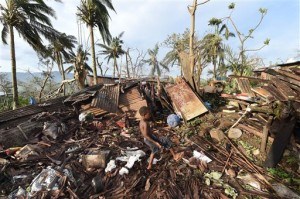Pacific Islands devastated by Cyclone Pam at the weekend will be using the disaster to drive home the need for a globally funded insurance pool to aid in the recovery from such events when they attend climate-change talks in Paris later this year.

(AP Photo/Dave Hunt, Pool)
Ian Fry, the chief climate-change negotiator for the tiny island nation of Tuvalu, said the establishment of a permanent fund to help countries cope with the impact of climate-related disasters and other “slow-onset events” such as rising sea levels was a key goal for negotiations at the United Nations Climate Change Conference in Paris later this year.
“The [Intergovernmental Panel on Climate Change] have stated in their most recent report that these sorts of events are going to get worse as a result of climate change, and in fact they are getting worse,” Fry told Reuters on Tuesday. “There’s clearly a human imprint on these cyclones now, and there needs to be something done about it.”
Impoverished, low-lying Pacific Islands such as Vanuatu, Kiribati and Tuvalu are among the most vulnerable countries in the world to climate change and have long pushed for greater global action to combat it through bodies such as the Small Island Developing States (SIDS).
“Certainly, like Typhoon Haiyan dramatized the very real issue of the cost of climate change just before the Warsaw meeting (in 2013), this will ratchet up the anxiety and interest from the SIDS in the [Paris] negotiations,” said John Connor, chief executive of The Climate Institute, an Australia-based think-tank.
The presidents of Vanuatu and Kiribati both drew a clear link between global warming and the cyclone.
“Climate change is contributing to the disaster in Vanuatu,” said its president, Baldwin Lonsdale, as he rushed home from a conference in Japan.
Scientists agree that rising global temperatures mean more energy to fuel storms, since cyclones, hurricanes and typhoons can only form over warm waters. And a rise in sea levels of about 20 cms. (8 inches) in the past century means storm surges cause more damage when they hit land.
But the precise conditions in the atmosphere for cyclone formation are little understood, meaning that a category 5 storm like Pam that devastated Vanuatu, killing at least 11 people and leaving thousands homeless, could just be a freak of nature rather than a direct consequence of man-made climate change.
The last major assessment by the U.N. panel of climate scientists last year pointed out that little is known about the causes of cyclones and their trends. A better understanding could have billion-dollar implications for the defense of low-lying coasts from Miami to Pacific islands.
“There is low confidence that long-term changes in tropical cyclone activity are robust, and there is low confidence in the attribution of global changes to any particular cause,” it said.
A joint Australian/Vanuatu study in 2011 said it expected fewer but stronger cyclones to hit Vanuatu by the later part of the century.
Myles Allen of the University of Oxford said that, all things being equal, warmer temperatures implied more cyclones.
“Vanuatu’s president is right to ask the question,” Allen told Reuters. “There is good physical reason to think that climate change might have played a role. At the moment we don’t have the science to tell. It is a perfectly reasonable question. We don’t know the answer.”
(Reuters article: Additional reporting by Alister Doyle in OSLO; Editing by Will Waterman; AP Photo/Dave Hunt)





















 Weak La Nina Expected in the Central Region of the U.S. This Winter: NWS
Weak La Nina Expected in the Central Region of the U.S. This Winter: NWS  NC Supreme Court Bucks Trend, Finds COVID Caused Physical Loss to Restaurants
NC Supreme Court Bucks Trend, Finds COVID Caused Physical Loss to Restaurants  Embroker CEO Reflects on Tech, Insurance Journey
Embroker CEO Reflects on Tech, Insurance Journey  Soft Market Ahead? The Role of Digital Transformation for E&S Insurers
Soft Market Ahead? The Role of Digital Transformation for E&S Insurers 

